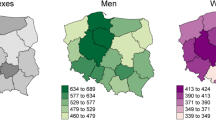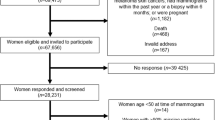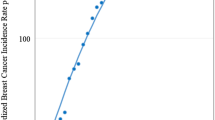Abstract
Reproductive-related factors play a major role in the aetiology of cancers of the breast, ovary and endometrium. Pregnancy history influences the risk of each of these cancers, and oral contraceptive use modifies the risks of ovarian and endometrial cancers, although its effect on breast cancer risk is less certain. We analysed recent time trends in the incidence and mortality of these cancers in England and Wales and assessed whether they can be explained by changes in fertility and oral contraceptive use. During 1962-87, there were significant increases in the overall incidence of breast cancer (0.95% increase per annum) and ovarian cancer (0.76% per annum) but little increase in endometrial cancer (0.13% per annum). At young ages incidence of each of the cancers has declined in recent years, whereas at older ages there have been substantial increases. Mortality data show similar time trends. In analyses by birth cohort, incidence of each of the cancers increased steeply for successive cohorts born before the turn of the century, and more slowly for cohorts thereafter, reaching a maximum for those born in the 1920s, and decreased for those born subsequently. The increases in incidence for women born before the turn of the century paralleled marked declines in their fertility. The fall in risk for women born after the 1920s was not accompanied by significant increases in their fertility, but coincided with the introduction and increase in use of oral contraceptives. For ovarian and endometrial cancers this accords with strong evidence from person-based studies of the protective effect of oral contraceptives. For breast cancer, the reasons for the recent decline are not clear. It would accord with recent suggestions of a long-term protective effect of oral contraceptives, on which further studies are needed. It is also possible, however, that changes in other risk factors such as dietary fat intake and menarcheal age might have contributed to the recent declines in the risk of these cancers.
This is a preview of subscription content, access via your institution
Access options
Subscribe to this journal
Receive 24 print issues and online access
$259.00 per year
only $10.79 per issue
Buy this article
- Purchase on Springer Link
- Instant access to full article PDF
Prices may be subject to local taxes which are calculated during checkout
Similar content being viewed by others
Author information
Authors and Affiliations
Rights and permissions
About this article
Cite this article
dos Santos Silva, I., Swerdlow, A. Recent trends in incidence of and mortality from breast, ovarian and endometrial cancers in England and Wales and their relation to changing fertility and oral contraceptive use. Br J Cancer 72, 485–492 (1995). https://doi.org/10.1038/bjc.1995.360
Issue Date:
DOI: https://doi.org/10.1038/bjc.1995.360
This article is cited by
-
Higher incidence of premenopausal breast cancer in less developed countries; myth or truth?
BMC Cancer (2014)
-
Increasing incidence of breast cancer: distinguishing between the effects of birth cohort and a national breast screening programme
Breast Cancer Research and Treatment (2009)
-
Ovarian cancer in younger vs older women: a population-based analysis
British Journal of Cancer (2006)
-
Ovarian cancer histology-specific incidence trends in Canada 1969–1993: age-period-cohort analyses
British Journal of Cancer (1999)



